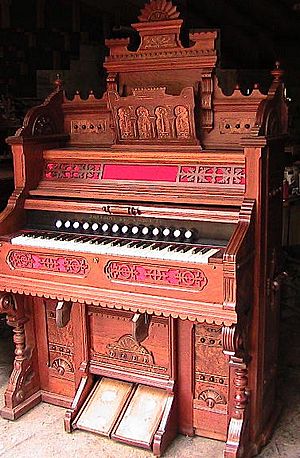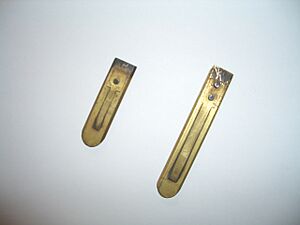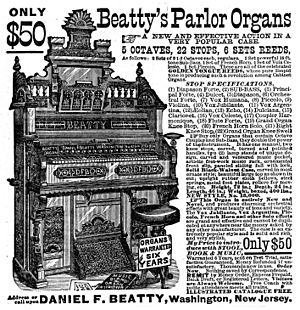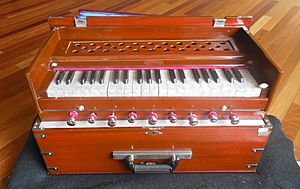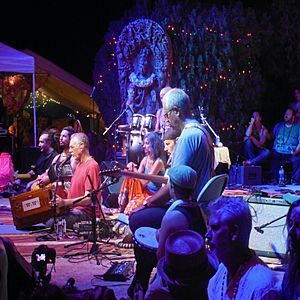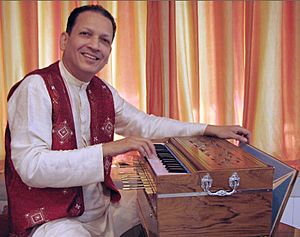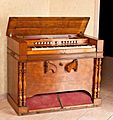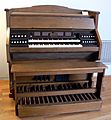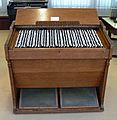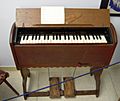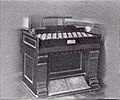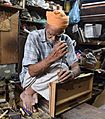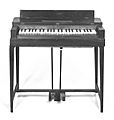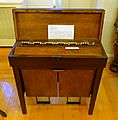Pump organ facts for kids
A pump organ is a musical instrument that makes sound when air blows past a thin, vibrating piece of metal called a reed. It's like a special type of organ. Some common types of pump organs are the reed organ, harmonium, and melodeon.
These organs were very popular in the 1800s and early 1900s. They were easier to move than large pipe organs, so many smaller churches and homes had them. They usually had one or two keyboards, but rarely had foot pedals. Millions of these organs were made in the US and Canada between the 1850s and 1920s. Companies like Estey Organ and Mason & Hamlin were well-known for making them.
Contents
History of Pump Organs
Early Designs and Inventors
The idea for the free-reed instrument, which pump organs use, came from Christian Gottlieb Kratzenstein in 1780. He was a professor in Copenhagen. The harmonium, a type of pump organ, was inspired by an older instrument called the regal.
In 1810, Gabriel-Joseph Grenié showed off an instrument he called an orgue expressif. This "expressive organ" could play louder (a crescendo) and softer (a diminuendo), which was new. Later, Alexandre Debain improved Grenié's design and patented it in 1840, calling it the harmonium.
Popularity in the West
Harmoniums became very popular in Western countries in the late 1800s and early 1900s. They were perfect for small churches and chapels that couldn't afford or fit a large pipe organ. They were also popular in homes.
These organs were lighter than pianos and didn't get damaged easily during travel. This made them great for shipping to faraway colonies where roads and railways weren't always good. Another big plus in hot, humid places was that they stayed in tune, unlike pianos. Some harmoniums were even treated with chemicals to stop woodworms!
Different Styles and Decline
Around 1900, many different styles of harmoniums were made. Some were simple, while others were fancy with lots of "stops" (knobs that change the sound). A few even had two keyboards or foot pedals, like a big pipe organ. These larger ones were mostly for people to practice at home. Smaller, foldable versions were made for missionaries or traveling musicians.
The invention of the electronic organ in the 1930s led to the end of the harmonium's popularity in the West. Electronic organs like the Hammond organ could sound like a pipe organ but were smaller and cheaper. They also needed less maintenance. The last big maker of harmoniums in North America, Estey Organ, stopped making them in the mid-1950s. Today, most Western harmoniums are owned by collectors, but they are still very popular in South Asia.
Music for Pump Organs
Western Classical Music
Many composers wrote music for the harmonium or for church organs that can also be played on a harmonium. For example, some pieces by Johann Sebastian Bach can be played on a four-octave harmonium.
Some famous composers who used the harmonium in their works include:
- Antonín Dvořák: Five Bagatelles for two violins, cello, and harmonium.
- Edward Elgar: Sospiri, Adagio for String Orchestra (can use harmonium).
- César Franck: Many pieces in his collection L'Organiste were written for harmonium.
- Gioachino Rossini: His Petite messe solennelle uses two pianos and a harmonium.
- Camille Saint-Saëns: The Barcarolle, Op. 108 is for piano, harmonium, violin, and cello.
- Richard Strauss: His opera Ariadne auf Naxos uses a harmonium.
Western Popular Music
Pump organs have been used in popular music since the 1960s.
- John Lennon played a harmonium on the Beatles' song "We Can Work It Out" and on the famous final chord of "A Day in the Life".
- Pink Floyd used it on their first album.
- Elton John used it on several albums.
- German singer Nico often used the harmonium as her main instrument in the late 1960s and 70s.
- Roger Hodgson from Supertramp used his harmonium on many of the band's songs, like "Fool's Overture" and the title track to "Breakfast in America".
The harmonium is also a key instrument in kirtan, a type of Hindu and Sikh devotional music. Many kirtan artists, like Jai Uttal, Snatam Kaur, and Krishna Das, play the harmonium.
Pump Organs in India
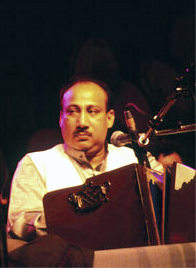
The harmonium is still very popular in the Indian subcontinent. It's a main instrument in North Indian classical music, Bengali music, and Sufi Muslim Qawwali concerts. You'll often find them in Indian and Bangladeshi homes.
The harmonium was changed in Bengal to fit Indian music better. Dwarkanath Ghose of the Dwarkin company made the hand-held harmonium. Indian musicians usually sit on the floor, so a hand-pumped instrument was more practical than one with foot pedals. Also, Indian music focuses on melody, so one hand can play the tune while the other pumps the bellows.
For a time, the harmonium was banned from All India Radio (from 1940 to 1971) because some felt it couldn't play the subtle slides and changes needed in Indian classical music. However, it's easy to learn and loud enough for concerts, so it became very popular for accompanying singers. Many top vocalists, like Bhimsen Joshi, use harmonium accompaniment.
Followers of Hindu and Sikh faiths use harmoniums for their devotional songs (bhajan and kirtan). Almost every mandir (Hindu temple) and gurdwara (Sikh temple) has one. In Sikhism, it's called a vaja or baja. It's also known as a peti (meaning "box") in some parts of North India.
Vidyadhar Oke created a special 22-microtone harmonium. This allows it to play the very specific small note differences needed in Indian classical music. Another improvement was made by Jogesh Chandra Biswas in 1954, who designed harmoniums that could fold down, making them much easier to carry.
The Shruti box is a simpler, keyless harmonium used just to make a continuous drone sound for other musicians.
Types of Pump Organs
Historical Instruments
-
This is a small pipe organ with bellows, not a pump organ.
-
This is a portable pipe organ with bellows.
-
This is an Accordion from around 1830.
Harmoniums (Pressure System)
These organs push air *out* through the reeds.
Suction Reed Organs (Vacuum System)
These organs pull air *in* through the reeds.
Melodeons
Reed Organs
Later Instruments (Electric)
-
An Electrostatic-pickup reed organ from the 1930s–60s.
-
This is an Electronic organ from 1939 or later.
Images for kids
See also
 In Spanish: Armonio para niños
In Spanish: Armonio para niños


